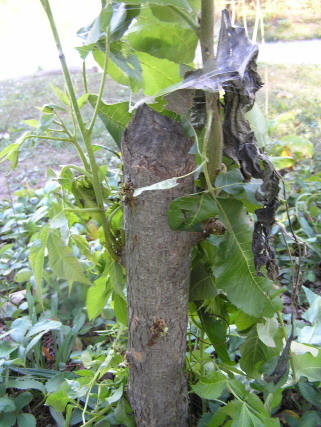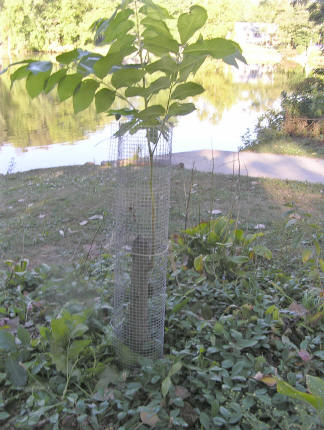 Not everybody in Adams County has to deal with the
aftermath of a beaver visit. Most people do not live on a lake or stream. On the other hand, quite a few people do, given Tom’s Creek, Codorus Creek, Marsh Creek, Conewago
Creek, Rock Creek, Lake Heritage, Lake Kay, Lake Carroll, and Lake May all prime natural resources in the County. Creeks and lakes are the natural habitat of the beaver,
whose prime pelts gave the economic motivation for exploration of northern North America by the French fur traders in the 16th and 17th centuries. Those days are gone but the
beaver as well as his neighbor the white tailed deer have made a significant comeback.
Not everybody in Adams County has to deal with the
aftermath of a beaver visit. Most people do not live on a lake or stream. On the other hand, quite a few people do, given Tom’s Creek, Codorus Creek, Marsh Creek, Conewago
Creek, Rock Creek, Lake Heritage, Lake Kay, Lake Carroll, and Lake May all prime natural resources in the County. Creeks and lakes are the natural habitat of the beaver,
whose prime pelts gave the economic motivation for exploration of northern North America by the French fur traders in the 16th and 17th centuries. Those days are gone but the
beaver as well as his neighbor the white tailed deer have made a significant comeback.
My first direct experience with a beaver on Lake Kay occurred about 10 years ago. He (or she) started making a meal of my neighbor’s young succulent
trees as they are wont to do. One frustrated neighbor immediately dug the stump and the roots from the ground then put wire around all his surviving trees. My next door
neighbor lost a tree when she was out of town; I surrounded the remaining trees with chicken wire and kept them at bay until her return. Chicken wire is inexpensive, readily
available and easy to work. That is the positive view. The negative view is that it doesn’t last. As corrosion sets in, the wire sort of collapses into a thin ring at the
base of the tree, thus exposing the succulent bark to further trepidations. Those beaver were removed legend has it, and there was peace in the valley for several years.
 A few months ago I saw a brown wide-headed creature swimming in Lake Kay. I frequently see muskrats swimming in the Lake but this head was far too
broad for a muskrat. I thought to myself, that’s a beaver. I had better replace the chicken wire that I had placed around the 3 pecan trees that the borough had planted in
Lake Kay Park several years ago. The trees were now about 2" in diameter and bearing pecans. Truthfully, there were only 3 pecans but I will take all I can get.
A few months ago I saw a brown wide-headed creature swimming in Lake Kay. I frequently see muskrats swimming in the Lake but this head was far too
broad for a muskrat. I thought to myself, that’s a beaver. I had better replace the chicken wire that I had placed around the 3 pecan trees that the borough had planted in
Lake Kay Park several years ago. The trees were now about 2" in diameter and bearing pecans. Truthfully, there were only 3 pecans but I will take all I can get.
Some preach that procrastination is a sin, and in my case it was. About a week after that thought I got around to taking not chicken wire, but ½"
hardware cloth to the park to renew the trees protection. Alas, I was too late. Of the three trees, one was a beauty having bore the 3 pecans last year, one was so-so and one
had died to be replaced by a stratified and started pecan growing in a tree tube shelter. Guess which one the beaver had struck!! Of course if you guessed the best one you
win the prize! If you do an internet search on Bill Devlin Pecans you will come to my article on growing pecans in South Central Pennsylvania.
 In my 70 years of growing pecans and clearing undesirable trees that were crowding my favored pecans, I have developed a great respect for the ability
of a tap rooted tree to survive a simple beheading. The root system is at least as extensive as the above ground system, reaching out to the ‘drip line’; the area covered by
the leaf canopy, and has a vast reservoir of energy to restore a damaged or removed top. It is really, really, really hard to kill a tap root tree. On my farm I have resorted
to using a large diesel tractor to literally yank them out of the ground, roots and all (up to 4" trees) as hardly anything else works. Expensive poisons will occasionally
work but are somewhat dangerous to work with. I have on occasion had a backhoe available for other work like building creek crossings with culverts, and diverted the backhoe
to removing trees like locust as nothing else, not even poison works.
In my 70 years of growing pecans and clearing undesirable trees that were crowding my favored pecans, I have developed a great respect for the ability
of a tap rooted tree to survive a simple beheading. The root system is at least as extensive as the above ground system, reaching out to the ‘drip line’; the area covered by
the leaf canopy, and has a vast reservoir of energy to restore a damaged or removed top. It is really, really, really hard to kill a tap root tree. On my farm I have resorted
to using a large diesel tractor to literally yank them out of the ground, roots and all (up to 4" trees) as hardly anything else works. Expensive poisons will occasionally
work but are somewhat dangerous to work with. I have on occasion had a backhoe available for other work like building creek crossings with culverts, and diverted the backhoe
to removing trees like locust as nothing else, not even poison works.
With this in mind, I undertook a mission to save the tree. Since the cut was about a foot above the ground, and the Pawnee variety graft was about 3"
above the ground, the original planting can be restored.
The vast reservoir of energy that I previously referred to kicked into action and about a dozen buds appeared on the stump of the tree, see photo. In
this photo I have already for the first time removed all but one set of buds. This process of removing extraneous buds may need to be repeated at intervals. The process
forces the root system energy into feeding the main leader that will become the renewed tree. I believe that in 2010 the tree will be seen as normal, except to an expert eye.
Summarizing What to Do After the Beaver Comes:
Do NOT Panic and destroy the stump.
Read other articles By Bill Devlin